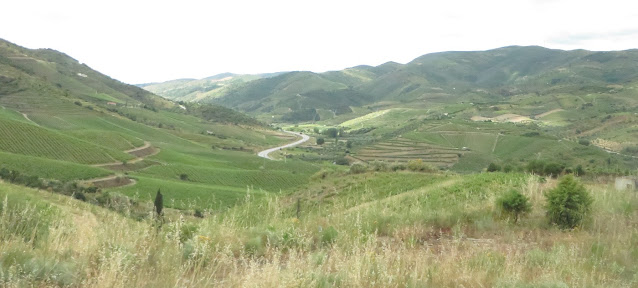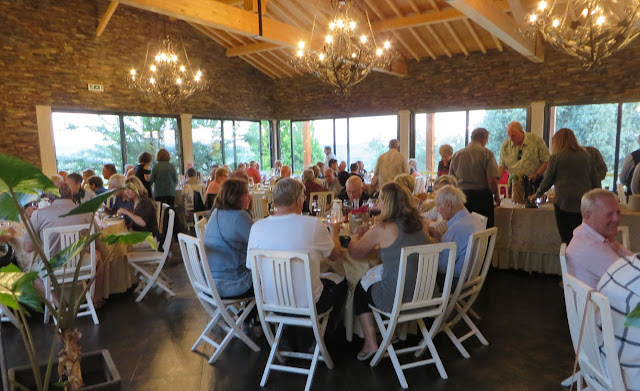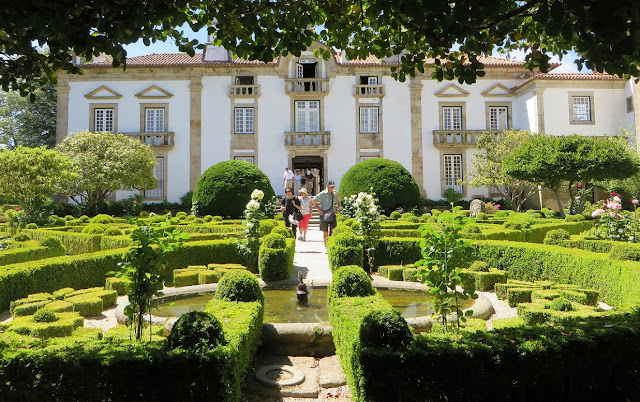Tour Day 5
The sun was not yet up as I got a boarding pass and left the Queen Isobel and walked to Portugal – which meant walking half way across the bridge – about 750 metres. The border between Spain and Portugal runs down the middle of the river. I took a sunrise photo from Portugal of the ship berthed in Spain, and returned for a shower and an excellent breakfast.
Queen Isabel in Spain. Photo taken from Portugal.
At 8:45 the buses departed to take us to Castelo Rodrigo, a medieval town that has not been updated to reflect modern society. Luis, or tour director, gave us a lengthy spiel on local history, involving the Romans, the Moors (Arabs & Berbers), Spanish and Portuguese. It was fascinating. It took the Moors eight years to fully settle the Iberian peninsula, and the Catholics 700 years to get it back. However, as we have heard in other places on this trip, the Muslims, Jews and Catholics got on with each other and actually thrived together.
On the way there we saw a number of local birds of prey such as Egyptian Vultures and Falcons, as the drive took us from 125 metres above sea level to 900 metres above sea level.
After our stroll around the town, which is at the top of a hill, we were treated to a taste sensation of local wines, and local almonds in about 10 different forms.

It was then back to the ship, which had moved downstream from where we had left it, and a light lunch. The drive to and from Castelo Rodrigo had been though very hilly country which was mostly covered in olive trees, grape vines, almond trees and a few other forms of agriculture.
How Scenic is That?
Most of the hills were terraced which provides a natural irrigation for the trees and vines. This form of terracing was introduced by the Moors who conquered the Iberia peninsula (Spain & Portugal) in 711. We also noticed many Aussie eucalypt trees which are used locally for eucalyptus oil. We also had cork trees pointed out to us, with the cork being stripped from the trees every nine years. Cork is used here for wine bottles (surprise, surprise), and the manufacturer of handbags, wallets, shoes, hats and belts. Shirley thought that an investment was worthwhile.
Raw Cork as Stripped from the Trees
Apparently in Portugal screw tops are only used on cheap wines.
The Queen Isabel continued to move downstream, first passing a 22 metre lock then a 30 metre lock. All of the locks on the Douro river have hydro-electric generation capacity.
The hills either side were still terraced and still contained grape vines and olive trees. The sides of the valley were often very steep, and mostly too hard to attempt a walk (if we could have) – so I spent 30 minutes on the walking machine in the gym.
The views were spectacular with small villages appearing occasionally. Around 5:15 we docked at Pinhao, and we all got ready for dinner at Quinta da Avessada Wine Estate. The temperature outside was in the mid 20’s.
Again the three buses were loaded and we set off, via a twisting, turning, climbing road that had unbelievable views. Again the slopes were mountain goat stuff, and were covered with grape vines. In many places the terracing was so pronounced that the terrace walls were made of rock. The amount of rock that has been used to make the walls and the effort that must been expended in building them is mind boggling.
Terracing Supported by Rock Walls. The terracing width is determined by the slope of the land.
We arrived at Quinta da Avessada Wine Estate to the sound of a piano accordion and a drum and about eight staff clapping their hands. Our host was a Rowan Atkinson look-alike and he behaved the same – complete with voice and facial expressions. He was a great host, a great story teller, and a great comedian.
The traditional Portuguese food was excellent and plentiful, as was the local wine. Our host is the head of a local co-operative that has over 1000 hectares of grape vines, 80% of it muscatel. Their height above sea level means that they predominantly made white wines – very fruity and full of flavour. However, our host has a brother who lives at a lower altitude and makes red wine.
A Wonderful Dinner in the Hills above Pinhao
We were sort of glad that it was a dark night and we could not see over the edge of the road as we headed home.
Day 35 – Tuesday 7 June 2016 – Douro River
Tour Day 6
I had an early shower and was on the top deck to see the sunrise – my favourite time of day. If I had opened the curtains in our stateroom it would have hit the pillows. Life is OK.
Sunrise on the Douro
Our next adventure was to the Quinta de Seixo – a popular and famous local winery. Their list of credits includes Mateus Rose. There are insufficient words in the English language to describe the roads and the scenery that we covered and viewed. Words like spectacular, scary, amazing, beautiful, scenic, steep, green are words that could be used. The driveway into the winery itself was narrow, steep, cobble-stone and picturesque. All in all the trip was magnificent.
A Thing of Beauty is a Joy Forever
The beauty of our location was nearly matched by the quality of the white and ruby port, in spite of the fact that it was only 9:25 am.
Morning Tea - Red & White Port
After the tour the three musketeers had time for a touristic walk in Pinhao. I was regretting the fact that Shirley was still safe-guarding my cash and credit card from last night. However, all was good and both got back to the ship intact.
Shirley and Fay rested with a light lunch in the lounge room while I joined two couples (UK & USA) in the dining room for a slightly larger lunch. It seemed appropriate to wash the lunch down with a glass of Mateus Rose.
The sides of the Douro valley were still very steep and covered in vines. As we passed yet another lock the valley changed slightly in that there were areas that were relatively flat – but still sloping.
It was a rest period and I missed the Portuguese lesson as I was trying to fix the internet connection.
We had now berthed at Regua. Soon after we crossed the road to the Museu do Douro for an informative session on wines (what else). We soon learned that the people of the Douro have learned that the local shale rock can be fully utilised in the often dry conditions. A grape vine root is planted in a one metre deep hole, and the desired grape style is grafted to the root stock. The root then goes further down looking for water – in many cases 10’s of metres. The shale surfaces protects the sub-surface and in turn the root stock.
Olive, almond and elder trees may be planted around the perimeter to provide wind and erosion protection.
The Romans introduced grape vines to the Douro and the oldest recorded vine is said to be around 2400 years old.
Until recent times port wine could be purchased at a pharmacy as it was classed as a digestive.
Today was also “cocktail party” day, so we all cleaned up and headed off to the lounge for cocktails. We were warmly greeted by the friendly staff and were soon seated – drinking and chatting. It was a good way to precede dinner – another excellent ship meal, accompanied by the usual excellent wines.
Luis had explained that the reason that English has become a de-facto world standard was due to rock and roll music. It is something that you can play to, sing to and dance to. Therefore our resident entertainer, musician and singer spent the night singing rock songs. Near the end of the night I asked him to play a Portuguese song of his choosing. He did, and it was very moving.
Sleep was very easy.
Day 36 – Wednesday 8 June 2016 – Douro River – Regua
Tour Day 7
The usual start to the day was following by the usual bus ride – this time to a town of 15,000 people called Lamego. Luis claimed that the highlight of the visit was to be the Sanctuary to Our Lady of Remedios. It may be so, but we think that he wanted to see us walk down the 684 steps from the church to the main street of the town.
Sanctuary to Our Lady of Remedios
The Main Street Below the Steps
684 Steps up to Sanctuary to Our Lady of Remedios
I must admit that he did look after us with local tastes and flavours for morning tea – with the obligatory glass of wine – this time bubbly. The food included some lovely sweetbreads and hams.
Morning Tea
We wandered the town and invested in the local economy (cork and caffeine related).
We were back on the Queen Isabel just long enough for lunch when we ventured onto our next cultural experience. This time it was a visit to the town of Mateus and the Mateus Palace & Gardens – the home of Mateus Rose. It was 30 degrees as we arrived at our destination. Luis explained that we pronounce Mateus incorrectly. The best I could manage is something like mat-e-oos. My apologies to Luis if I am wrong.
Mateus Palace
Gardens Behind the Palace
The Palace was designed and built by an Italian architect in the middle of the 17th Century. All ceiling are made of chestnut wood. It would have been a magnificent home to live back then. The palace contains a religious museum, which consists of two rooms that have items of religious significance. The key items of note seemed to be relics of saints and martyrs, such as their hair, teeth and bones. Hmmmmmmm.
Back on the ship it was a rest period before dinner. Around 6pm the Queen Isabel moved on from Regua and the sides of the valley changed from grape vines to lush green vegetation. There were also some lovely homes from time to time.
A Change in Vegetation
Dinner was the usual high standard, and enjoyable with good company. It was followed by a demonstration of how to open a bottle of liqueur port. The correct way involves using hot and cold to effectively break the bottle top just above the bottom of the cork. Once the port is decanted the decanter and wine are severely stirred to ensure that the wine character is stirred from its sleep.
Opening Liqueur Port
Day 37 – Thursday 9 June 2016 – Douro River – Entre-os-Rios (Amarante)
Tour Day 8
It was a leisurely as the morning was scenic sailing on the Douro. So we slept in, had a late breakfast and lounged away the morning. Many of us listened to a talk by Luis called Portuguese Seafarers & Spanish Explorers. It was very interesting.
Around mid morning we passed through the lock at Carraparelo dam, which is the largest lock on the Douro. During lunch we docked at Entre-os-Rios.
The Lock at Carraparelo dam
After lunch the bus took us to Amarante, which has a significant place in history due to its resistance to Napoleon’s invasion around 1806. Taking the bridge in the photo below was the key to winning the battle. Portugal regained its independence with the help of the Duke of Wellington – just over 200 years ago.
Our walking discovery tour started with the fable as to why the rooster is a Portuguese symbol for good luck, before we visited the church of St Gonzales (the town’s patron saint) – another historically significant church in early Portugal.
Church of St Gonzales
I took a photo of the various forms of cobbles stones that are used widely in Portuguese streets, minor roads and footpaths. Most are granite, but limestone is also used and often where other countries may paint a line – as would be the case for a pedestrian crossing.
Left – Limestone cobbles. Middle – Larger granite cobbles for roads/streets. Right – Smaller granite cobbles for footpaths.
The tour included a visit to an excellent pastry shop where the pastry pictured here is termed “playful”.
From Amarante we drove to Quinta Aveleda, famous for its gardens and its delectable Vinho Verde – its famous green wine. However the wine is termed green because of its youth, not its colour. The winery produced 16 million bottles of wine per year. The 19th century style garden covers 25 acres and is stunning. The biggest and oldest feature is a 50 metre high 200 year old Aussie eucalypt. The photo collage below shows some of the colours of the garden.
Dinner was another excellent meal, accompanied by the best red of the cruise so far. The head waiter convinced me that the (free) house wine was a good as the €20 feature red – so house red for me.
*** This Post is Complete ***
Post Updated 11 am Sunday 12 June 2016
Church of St Gonzales
I took a photo of the various forms of cobbles stones that are used widely in Portuguese streets, minor roads and footpaths. Most are granite, but limestone is also used and often where other countries may paint a line – as would be the case for a pedestrian crossing.
Left – Limestone cobbles. Middle – Larger granite cobbles for roads/streets. Right – Smaller granite cobbles for footpaths.
The tour included a visit to an excellent pastry shop where the pastry pictured here is termed “playful”.
From Amarante we drove to Quinta Aveleda, famous for its gardens and its delectable Vinho Verde – its famous green wine. However the wine is termed green because of its youth, not its colour. The winery produced 16 million bottles of wine per year. The 19th century style garden covers 25 acres and is stunning. The biggest and oldest feature is a 50 metre high 200 year old Aussie eucalypt. The photo collage below shows some of the colours of the garden.
(Photo Collage of the) Gardens of Quinta Aveleda
Dinner was another excellent meal, accompanied by the best red of the cruise so far. The head waiter convinced me that the (free) house wine was a good as the €20 feature red – so house red for me.
*** This Post is Complete ***
Post Updated 11 am Sunday 12 June 2016






















No comments:
Post a Comment